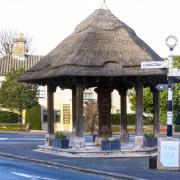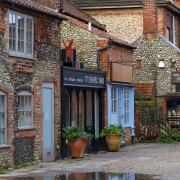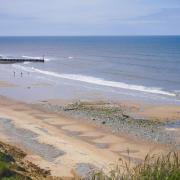The pretty village on the north Norfolk coast.
Seahenge
Exactly 4,074 years ago a huge oak tree was felled, close to the north Norfolk coast, up-ended and surrounded by a circle of wooden posts hewn from more oaks.
It might have been used as a temple – perhaps even to do with summer solstice which falls on the 21st of this month. Or the upturned tree roots might have been a place where dead bodies were exposed to the elements and picked clean by birds as part of ancient funeral rituals.
Eventually the sea engulfed the tree circle, or henge, and it was lost until 1999 – when the submerged Bronze Age timbers, dubbed Seahenge, were once again visible at the lowest tides.
Exposed to the air once more it would have decayed rapidly had it not been dug out and preserved. Tree ring dating revealed the exact year and season the trees had been felled
The central stump and many of the surrounding posts can be seen in Lynn Museum but a second henge occasionally resurfaces off Holme beach. It had two central oak logs surrounded by an oval of posts, interwoven with branches, and an outer palisade and was photographed this winter.
Routes
Holme-next-the Sea is the junction of two long distance paths – the coastal footpath and ancient Peddars Way, which marches along a Roman route down to Knettishall Heath in Thetford Forest but is also part of the millenia-old chalk ridgeway, which linked the north Norfolk coast to Lyme Regis in Dorset and has been called Britain’s oldest highway. A ferry probably took travellers on across the Wash to present-day Lincolnshire.
A new 360-mile cycle route was recently mapped along the ancient Chalk Way and cyclists will also be rolling past Holme-next-the-Sea on Sunday June 4 when the 200-mile Round Norfolk Epic route takes in the A149 coast road as part of a ride circling the entire county.

Nature reserve
Holme Dunes National Nature Reserve is alive with birds including avocet, little tern, black-tailed godwit, ringed plover, redshank, lapwing, bittern, marsh harrier and shoveler at this time of year. There are natterjack toads, southern marsh orchids and sea lavender too. Barn owls swoop over the grazing marshes and in spring and autumn thousands of migrating birds pass through.
The Norfolk Wildlife Trust reserve has hides overlooking pools and grazing marshes, a small shop, café and visitor centr and also includes the remains of railway built as a target for artillary training.
You ok Hun?
The tiny, but internationally important, river Hun runs just four miles, from Hunstanton Park to Holme Dunes. It is one of Norfolk’s chalk streams - There are only around 210 worldwide – and, with the river Stiffkey, is part of a Norfolk Rivers Trust and the Norfolk Coast Partnership project called Restored, Revitalised, Resilient improving water quality and its wildlife habitat.
Open gardens
Villagers will be opening their gardens on July 2.
The annual Holme-next-the-Sea Open Gardens Day is organised by the volunteers of the Help Holme Church Group and will include stalls in several gardens and refreshments at the village hall.
For just £5 per adult (children free) people can visit all the open gardens, with a free bus service between sites – which include gardens with ponds, and the popular plant stall at Berkeley House.
All proceeds from the open gardens day help maintain medieval St Mary’s church – where there will be floral displays to admire.



























